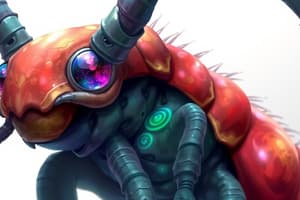Podcast
Questions and Answers
What is the phylum for sponges?
What is the phylum for sponges?
- Porifera (correct)
- Mollusca
- Cnidaria
- Annelida
Which of the following are classes of the phylum Cnidaria? (Select all that apply)
Which of the following are classes of the phylum Cnidaria? (Select all that apply)
- Anthozoa (correct)
- Turbellaria
- Scyphozoa (correct)
- Hydrozoa (correct)
What is the phylum for flatworms?
What is the phylum for flatworms?
Platyhelminthes
What is the phylum for roundworms?
What is the phylum for roundworms?
What is the phylum for rotifers?
What is the phylum for rotifers?
Which of the following classes belong to the phylum Mollusca? (Select all that apply)
Which of the following classes belong to the phylum Mollusca? (Select all that apply)
What is the phylum for segmented worms?
What is the phylum for segmented worms?
What is the subphylum for jointed foot organisms?
What is the subphylum for jointed foot organisms?
Which of the following are classes within the phylum Echinodermata? (Select all that apply)
Which of the following are classes within the phylum Echinodermata? (Select all that apply)
What is the class of the phylum Cnidaria that includes jellyfish?
What is the class of the phylum Cnidaria that includes jellyfish?
Match the following classes with their corresponding phylum:
Match the following classes with their corresponding phylum:
Flashcards are hidden until you start studying
Study Notes
Invertebrate Classification
-
Porifera: Phylum of sponges, characterized by a porous body and lack of true tissues and organs.
-
Cnidaria: Phylum including coelenterates with stinging cells and a hollow digestive cavity; classes include Hydrozoa (hydra, Portuguese man-o-war), Scyphozoa (jellyfish), and Anthozoa (coral, sea anemone).
-
Platyhelminthes: Phylum of flatworms, features three main classes: Turbellaria (planaria), Trematoda (flukes), and Cestoda (tapeworms).
-
Nematoda: Phylum of roundworms, distinguished by their cylindrical body shape.
-
Rotifera: Phylum that includes rotifers, microscopic and generally aquatic organisms.
-
Mollusca: Phylum characterized by soft-bodied organisms often protected by shells; includes classes Polyplacophora (chitons), Gastropoda (snails, slugs), Pelecypoda (clams, oysters), and Cephalopoda (octopuses, squids).
-
Annelida: Phylum of segmented worms; major classes are Oligochaeta (earthworms), Polychaeta (marine worms), and Hirudinea (leeches).
-
Arthropoda: Phylum with jointed-foot organisms, divided into subphyla Crustacea (crabs, lobsters), Chelicerata (spiders, scorpions), and Uniramia (insects, millipedes, centipedes).
-
Echinodermata: Phylum of marine animals with spiny skin; includes classes Echinoidea (sea urchins, sand dollars), Asteroidea (starfish), Crinoidea (sea lilies), Holothuroidea (sea cucumbers), and Ophiuroidea (brittle stars).
Subphylum Details
-
Crustacea: Subphylum of Arthropoda; features cephalothorax, antennae, mandibles, and typically five pairs of legs and swimmerets.
-
Chelicerata: Subphylum of Arthropoda; characterized by the absence of antennae, presence of chelicera (pinching mouthparts), and four pairs of legs; includes classes Merostomata (horseshoe crabs) and Arachnida (spiders, ticks).
-
Uniramia: Subphylum of Arthropoda; features chewing mouthparts and one pair of antennae; includes classes Diplopoda (millipedes), Chilopoda (centipedes), and Insecta (ants, bees, beetles).
Class Specifics
-
Hydrozoa: Class within Cnidaria, includes freshwater and marine species such as hydra and Portuguese man-o-war.
-
Scyphozoa: Class within Cnidaria, includes true jellyfish like Aurelia.
-
Anthozoa: Class within Cnidaria, encompasses coral and sea anemones.
-
Turbellaria: Class of Platyhelminthes known for planarians.
-
Trematoda: Class of Platyhelminthes, includes parasites like flukes.
-
Cestoda: Class of Platyhelminthes, known for parasitic tapeworms.
-
Polyplacophora: Class of Mollusca, known for having many plates; includes chitons.
-
Gastropoda: Class of Mollusca, features univalves or "stomach-footed" species like snails and slugs.
-
Pelecypoda: Class of Mollusca, includes bivalves such as clams, oysters, and scallops.
-
Cephalopoda: Class of Mollusca, characterized by a head-foot structure; includes octopuses, squids, nautilus, and cuttlefish.
-
Oligochaeta: Class within Annelida, represented by earthworms.
-
Polychaeta: Class of marine annelids known for their bristle-like appendages, such as feather duster worms.
-
Hirudinea: Class of Annelida, includes leeches.
-
Arachnida: Class of Arthropoda within Chelicerata; includes spiders, ticks, scorpions, and mites.
-
Merostomata: Class of Chelicerata; includes horseshoe crabs.
-
Diplopoda: Class of Uniramia; known for millipedes.
-
Chilopoda: Class of Uniramia; includes centipedes.
-
Insecta: Class of Uniramia; encompasses many diverse species including ants, bees, and beetles.
-
Echinoidea: Class within Echinodermata; includes sea urchins and sand dollars.
-
Asteroidea: Class within Echinodermata; known for starfish.
-
Crinoidea: Class within Echinodermata; includes sea lilies and feather stars.
-
Holothuroidea: Class within Echinodermata; known for sea cucumbers.
-
Ophiuroidea: Class within Echinodermata; includes brittle stars.
Studying That Suits You
Use AI to generate personalized quizzes and flashcards to suit your learning preferences.




